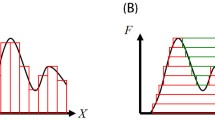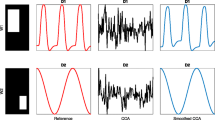Abstract
This paper presents recently developed Enhanced Multivariance Product Representation (EMPR) method for multivariate functions. EMPR disintegrates a multivariate function to components which are respectively constant, univariate, bivariate and so on in ascending multivariance. Although the EMPR method has the same philosophy with the High Dimensional Model Representation (HDMR) method, it has been proposed to get better quality than HDMR’s with the help of the support functions. For this purpose, we investigate the EMPR truncation qualities with respect to the selection of the support functions. The obtained results and a number of numerical implementations to show the efficiency of the method are also given in this paper.
Similar content being viewed by others
References
I.M. Sobol, Sensitivity estimates for nonlinear mathematical models. Math. Model. Comput. Exp. (MMCE) 1, No. 4.407 (1993)
Rabitz H., Alış Ö.: General foundations of high dimensional model representations. J. Math. Chem. 25, 197–233 (1999)
Alış Ö., Rabitz H.: Efficient implementation of high dimensional model representations. J. Math. Chem. 29, 127–142 (2001)
Li G., Rosenthal C., Rabitz H.: High dimensional model representations. J. Math. Chem. A 105, 7765–7777 (2001)
M. Demiralp, M.A. Tunga, High dimensional model representation of multivariate interpolation via hypergrids. The Sixteenth international symposium on computer and information sciences (ISCIS XVI), pp. 416–423 (2001)
Demiralp M.: High dimensional model representations and its application varieties. Mathe. Res. 9, 146–159 (2003)
M.A. Tunga, M. Demiralp, Bound analysis in univariately truncated generalized high dimensional model representation for random-data partitioning: interval GHDMR. App. Numer. Math. (2008). doi:10.1016/j.apnum.2008.06.006
M.A. Tunga, M. Demiralp, Computational complexity investigations for high dimensional model representation algorithms Used in multivariate interpolation problems, 12th WSEAS international conference on applied mathematics, pp. 133–139, Dec 29–31, Cairo, Egypt (2007)
Tunga M.A., Demiralp M.: A factorized high dimensional model representation on the partitioned random discrete data. Appl. Num. Anal. Comp. Math. 1, 231–241 (2004)
Tunga M.A., Demiralp M.: A factorized high dimensional model representation on the nodes of a finite hyperprismatic regular grid. Appl. Math. Comput. 164, 865–883 (2005)
B. Tunga, M. Demiralp, Support function influences on the univariance of the enhanced multivariance product representation, Seventh International Conference of Computational Methods in Sciences and Engineering (Rhodes, Greece, 2009)
M. Demiralp, Important aspects of enhanced multivariance product representation, (to be published)
Oevel W., Postel F., Wehmeier S., Gerhard J.: The MuPAD Tutorial. Springer, Berlin (2000)
Author information
Authors and Affiliations
Corresponding author
Rights and permissions
About this article
Cite this article
Tunga, B., Demiralp, M. The influence of the support functions on the quality of enhanced multivariance product representation. J Math Chem 48, 827–840 (2010). https://doi.org/10.1007/s10910-010-9714-2
Received:
Accepted:
Published:
Issue Date:
DOI: https://doi.org/10.1007/s10910-010-9714-2




